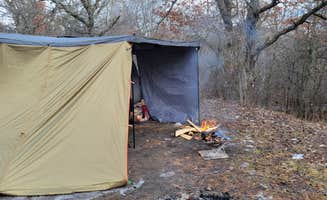South of Sand Dunes State Forest provides dispersed camping near Burnsville, Minnesota with minimal site development. Located in Sherburne County, the forest sits on sandy soil from glacial deposits, creating a unique ecosystem of jack pines and oak savanna. Winter temperatures often drop below 0°F, while summer brings 80-90°F days with high humidity levels that contribute to abundant mosquito populations from May through September.
What to do
Birding opportunities: Visitors can spot sandhill cranes and various woodland species throughout the forest. "This is a nice quiet area. Some younger people coming through sporadically playing with their trucks but nothing serious and not often," notes Jason B. about South of Sand Dunes State Forest, who specifically highlighted the "lots of different bird sounds."
Wildlife awareness: Maintain distance from nesting birds during spring and summer months. "Stand storks are very protective. Stay away from them. They attack," warns Heather W., emphasizing the importance of respecting wildlife boundaries.
Trail exploring: Several unmarked paths branch from main roads, though many side trails remain closed to vehicles. "I just did an overnight camp one night in a truck camper and it was very easy to navigate... The bad part a lot of the side roads are closed to motor vehicles due to some issues they had a couple years ago," explains Adam W.
What campers like
Accessibility from urban areas: The forest provides quick escape options for Twin Cities residents. "I love that it's so close to home. I was able to walk in and find an incredible spot to camp and lay in my hammock," shares Joslyn H. about South of Sand Dunes State Forest.
Traffic patterns: Weekday visits typically offer more solitude than weekends. "Came back on a warm weekend. A bit more traffic, but after 12 p.m., not much of anything," reports Skip H., suggesting that midweek or afternoon arrivals may provide better site selection.
Vehicle accessibility: Most forest roads remain passable for standard vehicles during dry conditions. Samuel C. confirms, "Roads were totally fine for any vehicle. Most spots are like the pictures shown. There are a few spots that have great views or pull-through areas."
What you should know
Law enforcement presence: Camping regulations may be inconsistently enforced by different agencies. "I had a county sheriff person tell me it's not lawful to park a trailer and they kicked me out. I called the DNR and they said that wasn't right," recounts Jason B. from South of Sand Dunes State Forest.
Road safety concerns: Forest roads see higher traffic than typical remote areas. "This road is pretty busy for a dirt forest road and people FLY down it. Almost got hit a few times walking. Even through a Wednesday night cars are flying down the road," cautions Ryan P.
Environmental hazards: Beyond poison ivy, ticks present significant concerns from April through October. Alison O. advises, "Bug up at first signs of dusk—mosquitoes and ticks love these woods."
Tips for camping with families
Site selection strategy: Locations further from main access points provide greater quiet. "For the proximity to the city and nearby highways, this was a good spot... Overall there was some shouting and yelling but for the location I was happy," notes Samuel C. from South of Sand Dunes State Forest.
Safety planning: Limited cell service requires advance emergency preparations. Alison O. confirms the "Zero Bars, Zero Interruptions" situation, noting "bring a journal and some good company—your phone's chances are slim."
Educational opportunities: Sandy soil provides unique learning opportunities about glacial history and specialized ecosystems. Skip H. mentions the area is "Great spot. Plenty of parking," making it accessible for family vehicles.
Tips from RVers
Overhead clearance limitations: Many sites feature low-hanging branches unsuitable for taller rigs. Gregory reports about South of Sand Dunes State Forest: "We did find one we thought we liked, but branches over hung, and rested on our camper (8ft high) and in fact most sites were shaded."
Size restrictions: Small trailers fare better than larger RVs in most forest locations. Skip H. confirms sites are "Best for straight vehicles or very small trailers."
Regulatory confusion: Different agency interpretations about trailer camping creates uncertainty. "I called the DNR and they said that wasn't right but I decided to leave anyway. County sheriff's not pleasent around here," cautions Jason B. regarding his experience with differing enforcement practices.


